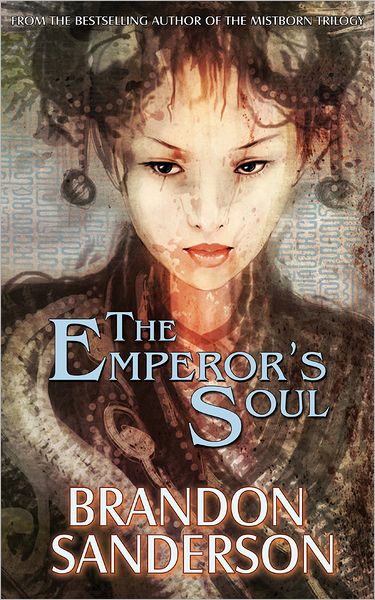At the start of Brandon Sanderson’s latest novella The Emperor’s Soul, Emperor Ashravan has just barely survived an assassination attempt. He’s alive thanks to his healers’ skills, but his mind has been wiped completely. The ruling Arbiters have managed to keep the fact that their Emperor has become a vegetable secret, thanks to the hundred day solitary mourning period he is expected to maintain for the death of his wife, the Empress, who died in the same attack. However, once that period runs out, it will become clear that the Emperor is no longer able to rule, and the power in the Empire will inevitably change hands….
It’s therefore an incredibly happy coincidence that the Empire has recently captured Shai, a master Forger with the magical ability to re-create and change objects and even people. Even though Forging is considered an abomination by the Empire, the Arbiters are left with little choice and set a bold plan in motion: they will force their prisoner to attempt the impossible and Forge a new soul for the Emperor, before the rest of the world finds out what happened…
In recent months, Brandon Sanderson has surprised his fans with two brand new novellas: first the contemporary fantasy/crime hybrid Legion (excerpt) and now The Emperor’s Soul (excerpt). Sanderson is best known for his long form epic fantasy: the Mistborn books, the Stormlight Archives, and of course the long-awaited final installments in Robert Jordan’s Wheel of Time. He’s a talented and extremely popular author, but most people probably weren’t expecting these shorter works, because brevity is not the first quality that comes to mind when you hear his name and he has a few other projects on his plate already. Still, it’s hard to get upset when an author is as incredibly productive as Sanderson. (Seriously, where does he find the time?)
The Emperor’s Soul is set in the same world as the author’s earlier novel Elantris, but it can be read completely independently and would actually serve well as an introduction to Sanderson’s works, just in case there’s anyone left who hasn’t read him yet. At the same time, the author’s fans will spot subtle references to a certain character who pops up in many of his novels, which will add a whole new dimension to this story.
Because of its shorter format, The Emperor’s Soul doesn’t have the same epic scale as Sanderson’s other works. Even though the fate of an empire hangs in the balance, the bulk of the novella focuses on the interactions between the Forger Shai and the Arbiter Gaotona during Shai’s imprisonment, giving the story an unexpectedly intimate and somewhat claustrophobic atmosphere: the stakes are high, but the camera is focused almost exclusively on the all-important work Shai is doing in captivity and against her will.
True to Sanderson’s First Law, the author makes sure that the reader understands every aspect of the magic system and every way it could or could not be used, starting from the very beginning of the novella when Shai is exploring ways to escape her prison. This level of detail will please those readers who enjoy getting into the intricacies of a magic system (almost a prerequisite if you want to enjoy Sanderson’s works), but in this case it takes up a large amount of space in a relatively short book.
What’s much more interesting is the way many of the scenes with Shai and Gaotona explore the magic system’s philosophical implications. What’s the value of a work of art if almost anything can be copied through Forging? What does it mean for a person’s identity when personalities, skills, or entire souls can be changed? As we learn, Shai was taught that “a Forger wasn’t a simple scam artist or trickster. A Forger was an artist who painted with human perception. […] Respect the people you lie to […]. Steal from them long enough, and you will begin to understand them.” On the other side, Gaotona at one point says, “a life full of lying makes reality and falsehood intermix,” being well aware that he is applying this same idea to the legitimacy of his empire’s ruler.
Truth be told, much like in Legion, it feels as if this story would have benefited from more space to breathe. Sanderson has a lot of material to work with in The Emperor’s Soul, but some of it is underdeveloped or merely hinted at: the rest of the empire, its politics and its past, the other Arbiters and Factions, Shai’s past, and of course the business with the scepter and the Imperial Fool. Some characters, like Captain Zu and the Bloodsealer, are barely defined at all. The Emperor’s Soul is an enjoyable novella, but it gives the impression that Sanderson crammed the outline for an entire novel into too few pages. The end result feels abbreviated and a bit unbalanced, like a section of a longer work that still needs to include enough exposition to make sense and, maybe because of this, leaves some other aspects undeveloped.
Still, The Emperor’s Soul is a worthy addition to Sanderson’s bibliography: a new magic system with some interesting implications, a couple of fascinating characters, a focused plot, and a subtle link to the much larger picture he’s been painting for years. I can’t shake the feeling that, given a few empty months in his busy writing schedule, Sanderson would have turned all of this into an amazing full length novel, but as it stands, The Emperor’s Soul is an enjoyable novella and a nice teaser for his next major work.
Stefan Raets reads and reviews science fiction and fantasy whenever he isn’t distracted by less important things like eating and sleeping. His website is Far Beyond Reality.










